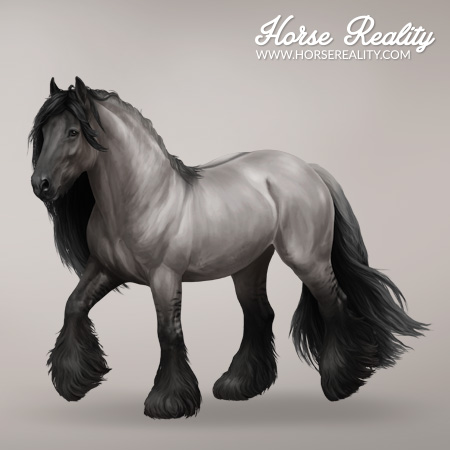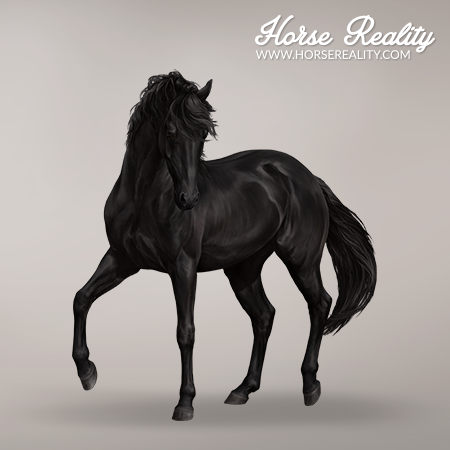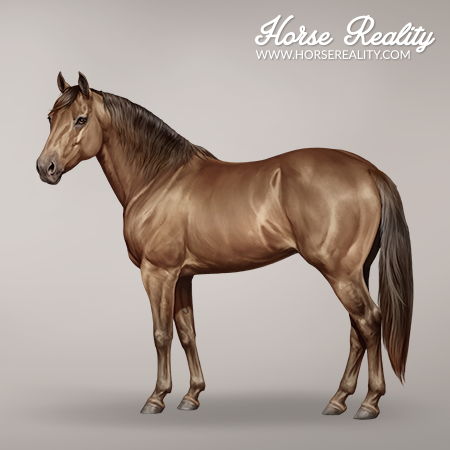Black is one of the base coat colours horses can have, next to chestnut and bay.
Black-based horses can also be affected by modifiers and/or dilutions, resulting in various other different colours.
¶ Phenotype
Black horses have a completely black coat, including the points (mane, tail, lower legs, ear tips) of the horse. Black shades can vary from pitch black to sun-faded black: Some black horses will “sun bleach”, which can be a result of exposure to sunlight, sweat, etc. or dietary or genetic factors. This might cause them to be mistaken for a dark bay or seal brown horse. Looking at the colour around the eyes and of the soft parts of the horse (muzzle, flanks,…) can help determine the colour; in bay-based horses, these parts will have a reddish colour.
Black foals usually have a more greyish colour when they are born, as a result of foal camo. On Horse Reality, the shade of black a horse gets once they turn into an adult is determined by chance.
| Black Base - Arabian Horse | |

|

|
¶
Genotype
Horses with the black base colour have at least one dominant extension allele (E/e or E/E) and are homozygous recessive for agouti (a/a). This can be tested at the Laboratory. They need at least one copy of the dominant E-allele to be able to produce black pigment, and two copies of the recessive a-allele in order for the pigment to be distributed over their entire bodies. This means the following genotypes will lead to black:
- E/E + a/a
- E/e + a/a
Breeding two black-based horses will always result in either a black or chestnut-based (in case both parents carry a recessive e-allele) foal. Chestnut and bay-based horses can only produce a black-based foal if they aren't homozygous dominant for agouti (A/A), so that is important to keep in mind when the aim is to breed a black-based horse.
¶ Modifiers and dilutions
The following modifiers and/or dilutions can act on the black base coat:
¶
Dilutions
Black-based coats can be lightened when other dilution alleles are present, sometimes drastically altering the appearance of the coat.
¶ Cream and Pearl
The cream and pearl alleles are located on the same gene. Cream is an incomplete dominant allele, however, black pigment is little to not diluted by heterozygous cream (CR/n). It is not possible to tell the difference between black and smoky black (CR/n) based on phenotype. Homozygous cream (CR/CR) dilutes black horses to a pale creamy colour called smoky cream.
Pearl is a recessive allele that also interacts with cream. Homozygous pearl (prl/prl) dilutes black horses to a tan or brown shade with mottled skin. CR/prl creates a lighter colour, more similar to homozygous cream.
| Black + Cream and Pearl - Pura Raza Española and Irish Cob Horse | |

Black + CR/n |

Black + CR/CR |

Black + prl/prl |

Black + CR/prl |
¶ Dun
The dominant dun allele (D) both dilutes and creates primitive markings (dorsal, leg stripes, etc.) on the coat. Black dun horses are also often called grulla or grullo. Non-dun 1 (nd1) is a mutation on the same gene that causes primitive markings, without the dilution effect.
| Black + Dun - Irish Cob Horse and Namib Desert Horse | |

Black + D/D, D/nd1, or D/nd2 |

Black + nd1/nd1 or nd1/nd2 |
¶ Champagne
Champagne (CH) is a dominant allele that dilutes bay horses to a tan colour with light brown mane and tail. The skin is mottled and the eyes have an amber-like colour. Black horses with champagne are called classic champagne. When heterozygous cream (CR/n) is present, the colour is called classic cream.
| Black + Champagne - Quarter Horse | |

Black + CH/CH or CH/n |

Black + CR/n + CH/CH or CH/n |
¶ Silver
The silver (Z) mutation, also called silver dapple or taffy, affects black pigment only. The body of black horses is little to not affected, but the mane, tail and feathers get diluted to a nearly white colour. Silver also often causes very pronounced dapples on black-based coats.
| Black + Silver - Finnhorse |

Black + Z/Z or Z/z |
¶ Breeds
Black is present in most horse breeds. The rarity of the colour can differ strongly between breeds; in some breeds such as the Friesian Horse it is the most common colour while in others, for example in the Namib Desert Horse, it can be very hard to find. The following table lists all breeds that can currently have the dominant extension (E) and recessive agouti (e) allele in-game.
| Breeds |
| Akhal-Teke Horse |
| Arabian Horse |
| Brabant Horse |
| Brumby Horse |
| Camargue Horse |
| Cleveland Bay |
| Exmoor Horse |
| Finnhorse |
| Fjord Horse |
| Friesian Horse |
| Haflinger Horse |
| Icelandic Horse |
| Irish Cob Horse |
| Kladruber Horse |
| Knabstrupper |
| Lipizzaner |
| Lusitano |
| Mongolian Horse |
| Mustang Horse |
| Namib Desert Horse |
| Noriker Horse |
| Norman Cob |
| Oldenburg Horse |
| Pantaneiro Horse |
| Pura Raza Española |
| Quarter Horse |
| Shetland Pony |
| Shire Horse |
| Suffolk Punch |
| Thoroughbred |
| Trakehner Horse |
| Welsh Pony |
¶ References
- Bellone R., Sponenberg D. P., Equine Color Genetics, 4th Edition, 2017, Wiley-Blackwell
- UC Davis Veterinary Genetics Laboratory; https://vgl.ucdavis.edu/test/red-factor-horse and https://vgl.ucdavis.edu/test/agouti-horse
- Generatio Center for Animal Genetics; https://generatio.de/en/knowledge/basic-genetics/coat-colours-horse, https://generatio.de/en/guidance/lexicon/extension-chestnut-base-colour-e-locus-horse and https://generatio.de/en/guidance/lexicon/agouti-bayblack-base-colour-locus-horse